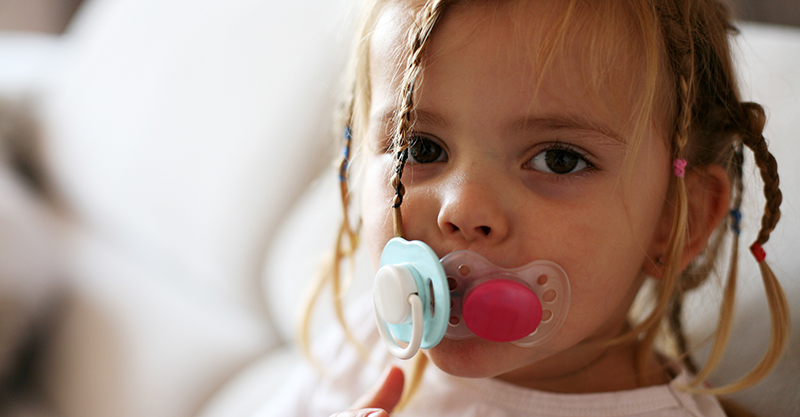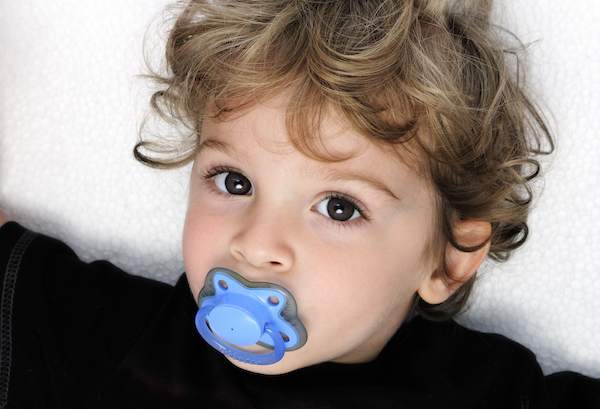Is ‘cold turkey’ the best way to help your child ditch the dummy?

When a mum of a four-year-old girl asked mothercraft nurse and Feed Play Love Live Helpline expert Chris Minogue about transitioning her child away from using a dummy, Chris knew exactly what to do. Her helpful advice is a must-read for anyone currently locked in a dummy battle (or preparing to enter the ring!)
“Cold turkey is the only way”
“Is cold turkey the way to go?” a conflicted mum asked Feed Play Love‘s Helpline. “We’ve tried this and she was hysterical. Or, is it better to let her have it [the dummy] until she understands a bit more? At the moment I think she sees [taking it away] as punishment.”
Chris agreed that cold turkey is the best approach for a child of this age, confirming four-year-olds are clever and resilient enough to process this big change.
“Your four-year-old has a lot of understanding, and cold turkey is the only way to get rid of it,” Chris advised. “There is no gentle way of doing it because she is four, so she has a lot of cognitive development. She knows what taking things away and replacing things is about.”
Preparation is key
While Chris notes that a four-year-old may feel very upset about having her dummy taken away, she explains that preparation – and following through – are key. She suggests planning the transition for a weekend, when there may be the option of calling in other family members (or friends) for support.
“I would sit her down, and say the dummies are going to go on Saturday, because you know the more people around to help the better. Then I would say to her on Wednesday, ‘you’re four now and four-year-olds don’t have dummies. So it’s time for the dummies to go, and we’re going to get rid of them on Saturday.'”
Explaining what’s about to happen without inciting too much anxiety in your child can be a tricky balance, so use restraint and try to avoid passing your own anxiety on to your child.
“Choose the day you’re going to do it and give her a little bit of warning, but don’t over talk it … it’s too confronting for them.”

Phasing the dummy out
Chris advises parents to throw all but ONE of the dummies out, in the days leading up to this transition.
“So you’re getting rid of all the dummies, there’s only one left by the day you’re actually going to take them away,” Chris says. “Then we literally just say ‘you’re a big girl now so hand your dummy over’ and we throw it out. You’ve got to comfort her in other ways and show her how she can get that resilience in going back down to bed again.”
“That might be by spending a little bit more time with her. Like listening to an audio story to help her relax before she goes to bed. It might be reading two stories and a cuddle, a longer cuddle initially to start with. When she gets up at night, it’s just about reinforcing, ‘yes, you’re okay. It’s time to go back to sleep again.'”
Some other comforting bedtime rituals in the place of the usual dummy can help to make the transition a little smoother.
“Pick your time frame, make sure you’ve told her,” Chris says, “and I would choose something like listening to an audiobook as a way of going back down to sleep.”

Recapping the seven stages of dummy withdrawal
- Let your child know when the last dummy day is (‘d-day!’)
- Remove all dummies from the house except for one
- Give your child a warning a few days before d-day, but don’t over talk it
- Plan an extra comforting bedtime ritual for d-day (see point 6)
- On d-day ask your child for the one surviving dummy – gently and kindly reinforcing that they can cope with this transition. Throw the dummy away
- At bedtime on d-day, give them some extra cuddles, an additional story or a new audiobook routine
- If they wake up, continue to gently and lovingly reinforce that they are okay – and settle them back to bed.
Do you have a question for mothercraft nurse, Chris Minogue? Join our weekly Live Helpline each Friday at 11.30am on Facebook.
To take part:
- Email us at helpline@theparentbrand.com.au
- Call Chris during the Babyology Facebook live every Friday from 11:30 am on 1800 543 772, or leave your question as a comment on the Live Helpline.









